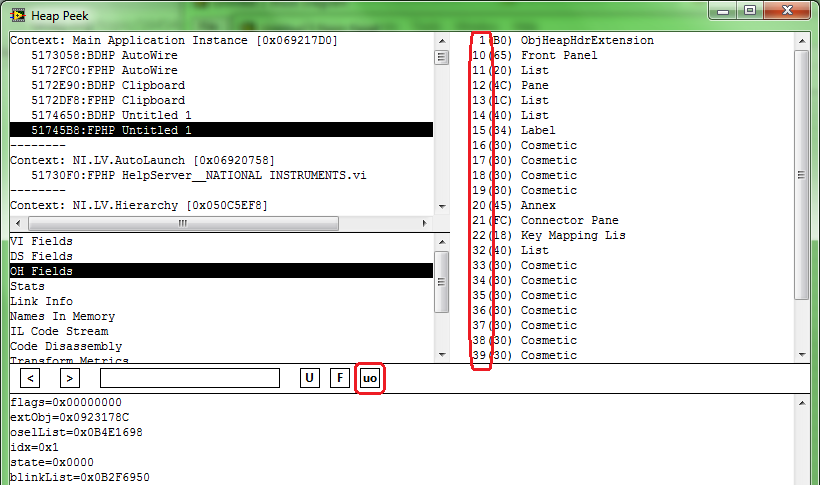-
Posts
122 -
Joined
-
Last visited
-
Days Won
13
Content Type
Profiles
Forums
Downloads
Gallery
Everything posted by Mr Mike
-
The new password checking is significantly more complex in terms of what it checks in the comparison. However, the new values that it uses are already known (loaded and/or computed) by that point in load, so the extra time is on the order of tens of microseconds, maybe hundreds of microseconds in particularly complex cases. Disclaimer: this estimate is based on personal knowledge of the change and how it works, not on actual recorded measurements. There are always efforts to improve load time, so I think that any negative effects this had (which is only visible on password protected VIs) are more than compensated for. Edit: I'm not 100% sure this check only happens on password protected VIs, so I'm redacting that part of the statement
-

Create your own Generic VI (like Randomize 1D Array)
Mr Mike replied to Sparkette's topic in LabVIEW General
Just be aware that doing something like that is truly playing with fire. flarn2006, I'd appreciate it you add a warning to your post to that effect, just like you did for the first one in this thread. -
My guess is that you're looking in the wrong context. If you scroll to the top of the heap list (the one you show in the image above), you'll see that they're broken up into contexts. In general, there are two contexts you will encounter: the Main Application Instance and Project contexts. The Main Application Instance contains VIs opened without a project. Project contexts have the VIs in a project that are on a specific device (i.e. My Computer or an RT Target). There are tons of other contexts that handle internal stuff, but your VI shouldn't be in those. Check all the contexts that sound relevant to your VI. If that doesn't work, I'll forward this to someone who knows better than I. I just use Heap Peak -- I've never seen how it works on the inside.
- 4 replies
-
- 1
-

-
- heap peek
- insane objects
-
(and 1 more)
Tagged with:
-
Click the uo button (I think it means "UID ordered") to sort the objects by UID. The UID is the first number in the rows (see attachment) That should help you find it. I don't know why it's not not showing up in order in the memory-ordered list.
- 4 replies
-
- 3
-

-
- heap peek
- insane objects
-
(and 1 more)
Tagged with:
-
It looks pretty much the same. Same filenames (mostly) and a few front panels are exactly the same. I reported the problem and it should be resolved shortly. Or at least that's what the 'report abuse' page told me. - Mike
-

This crashes LabVIEW on my computer
Mr Mike replied to MikaelH's topic in Development Environment (IDE)
It's still broken in a yet-unannounced version after LV 2012, whose version number remains entirely unguessable. I filed CAR 382426. I have no workaround, since I don't know much about the compile process. I've noted in the CAR to post the workaround here if there is one. -
What do you think is the best way to help users? In a recent thread I helped a user with a basic data transport / manipulation problem. My reaction to her problem was to show her how to solve the problem with a better way to program so that her application would be faster and more flexible in the future. I didn't rearchitect anything, just made a suggestion for a small change. Then rolfk came along and described a much simpler way to fix her problem. He acknowledged there were some potential problems in the design, but solved it quickly (i.e. with a simple cast) How do you try to help users? What would you have done in this case? Where do you draw the line between these two ways of helping?
-

tcp Sending Labview data via TCP
Mr Mike replied to Skeggy88's topic in Remote Control, Monitoring and the Internet
I think the problem is that you're not wiring a double into the Flatten To String. Check the length of the string produced by Flatten To String. It should only be 8 if you wire in a double. No more and no less. You had a node to convert the data wire to a double in the original. You should use that. I recognize the node, but I can't remember what it's called. (You might be able to use a regular Double conversion bullet). -

tcp Sending Labview data via TCP
Mr Mike replied to Skeggy88's topic in Remote Control, Monitoring and the Internet
I think that with the name 'Veronica,' the way you speak, and that you said "Sorry for my English" you're Italian. No? You can speak Italian here, here, and here. Penso che col nome 'Veronica,' Suo modo di parlare, e che Lei ha detto "Sorry for my English" Lei è italiana. No? Lei puo parlare in italiano qui, qui, e qui. Mi sono dimenticato la maggiorparte del mio italiano perche non l'ho parlato da 2006. Mi dispiace. -

tcp Sending Labview data via TCP
Mr Mike replied to Skeggy88's topic in Remote Control, Monitoring and the Internet
-

tcp Sending Labview data via TCP
Mr Mike replied to Skeggy88's topic in Remote Control, Monitoring and the Internet
Veronica, It would help if you posted an example of your LabVIEW code and Java code so we can understand what's going wrong. -
The VI Obj Cache allows multiple entries for a single VI depending on how it was compiled (e.g. for x86 or x64). The VI Obj Cache is touched every time LV runs. It's been a while since I played around with it, but I believe there's a time stamp for the last time the compiled code was used. That explains why it gets a new modtime. We'd really need more information to diagnose exactly what is happening. Exactly what, I'm not sure, but I'll forward this thread onto someone who knows more about it.
-
CAR 313044 (2011 known issue link). 2012 fixed issues link
-
I'm not at work (or VPN'd) in right now, but I do know which CAR you're talking about. It was fixed in LV 2012. mje, neil, Fab: what version are you using? The bug was specifically that edits to a diagram with many LV Class Properties took a long time. The time was proportional to the number of unique property items on the diagram.
-

New right-click like-items feature is kind-of bogus
Mr Mike replied to crelf's topic in Development Environment (IDE)
You guys ought to see some of AQ's attempts to make LV self aware. It's about as creepy as , crossed with . -

CLFN - linking with 32bit/64bit dll with same name
Mr Mike replied to L2L's topic in LabVIEW General
...and that's why I shouldn't try to help people first thing in the morning. -

CLFN - linking with 32bit/64bit dll with same name
Mr Mike replied to L2L's topic in LabVIEW General
What do you mean by linking? Do you just mean be able to use the DLL? You can wire in a path, but that will cause the connection (or "link" if you will) to the dll to not be made, so you'll need to remember to include the DLL every time you package up the files (or rather, anything that traverses the dependencies of a project). -
It will not be in a service pack. Service packs are for bugs that have either very low risk in fixing or cause serious problems. This is right in the middle of that spectrum, so it will not be in a service pack.
-
Yes, it was too late. The developer had the new implementation working, but no one was comfortable releasing something that had so little (internal or external) customer testing. Generally we're done with new code months before beta. There were talks about putting it in 2013, but I didn't follow closely enough to know what to expect.
-
That's what I thought at first too. However, the terminal takes up the whole left side of the top of the constructor node (the yellow part). A reference input is normally just the height of a terminal plus a few pixels into the yellow area.
- 10 replies
-
- error 1172
- constructor
-
(and 3 more)
Tagged with:
-
No, that's not supposed to happen. Filed as CAR 368608.
- 10 replies
-
- 1
-

-
- error 1172
- constructor
-
(and 3 more)
Tagged with:
-
Most people tend not to have extra expensive cards lying around unless they're for their own backup. Your best bet is to call the NI India Sales office, which is in Bangalore. Their number is 80 41190000. - Mike Benza
-
Scripting can be slow. In the LabVIEW source code we search each object for the text we're searching for. If the text is found we add the object to a list and traverse the objects within it (i.e. search inside a structure). Each object knows which attributes are searchable. When we search, we search all loaded block diagrams, which is (almost always) all loaded VIs. I bet the slowdown is in scripting. There may be a way to call the search method, since it is called from a LabVIEW dialog, and many LabVIEW dialogs are backed by LabVIEW code, but it's not public. You may want to contact Darren Nattinger and ask him if he knows of a method to call and possible make it public in future releases.
-
As the 2010 that guy, I can confirm you do not want to be that guy.
-

Random question for French LAVA members: what is your outlet polarity?
Mr Mike replied to Mr Mike's topic in LAVA Lounge
Allow me to correct that: my fiancée.


